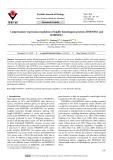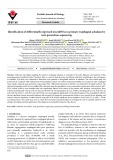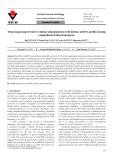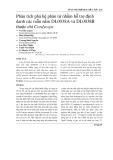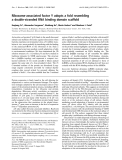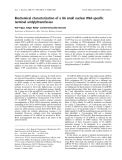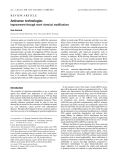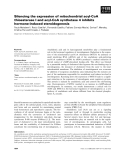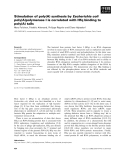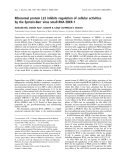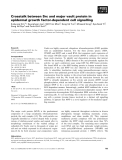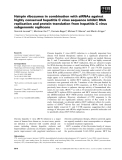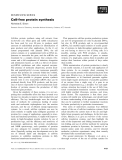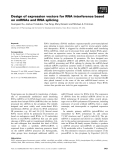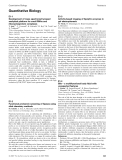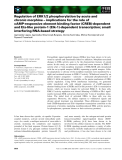
Small RNA
-
Early life exposure to adverse environments affects cardiovascular and metabolic systems in the offspring. These programmed effects are transmissible to a second generation through both male and female lines, suggesting germline transmission. We have previously shown that prenatal overexposure to the synthetic glucocorticoid dexamethasone (Dex) in rats reduces birth weight in the first generation (F1), a phenotype which is transmitted to a second generation (F2), particularly through the male line.
 15p
15p  vimichaelfaraday
vimichaelfaraday
 25-03-2022
25-03-2022
 16
16
 2
2
 Download
Download
-
Heterogeneous nuclear ribonucleoprotein (HNRNP) A1 and A2 are the most abundant HNRNPs with nearly identical functions, and play important roles in regulating gene expression at multiple levels (i.e. transcription, posttranscription, and translation). However, the expression and regulation mechanism of HNRNPA1 and A2 themselves remain unclear. In this study, the amino acid sequences of HNRNPA1 and HNRNPA2 were compared and found to have 78% and 86% homology in key functional domains.
 10p
10p  thiencuuchu
thiencuuchu
 27-11-2021
27-11-2021
 10
10
 1
1
 Download
Download
-
Molecular knowledge regarding the primary esophageal achalasia is essential for the early diagnosis and treatment of this neurodegenerative motility disorder. Therefore, there is a need to find the main microRNAs (miRNAs) contributing to the mechanisms of achalasia. This study was conducted to determine some patterns of deregulated miRNAs in achalasia. This case-control study was performed on 52 patients with achalasia and 50 nonachalasia controls. The miRNA expression profiling was conducted on the esophageal tissue samples using the next-generation sequencing (NGS).
 13p
13p  thiencuuchu
thiencuuchu
 27-11-2021
27-11-2021
 9
9
 2
2
 Download
Download
-
MicroRNAs (miRNAs) are small noncoding RNAs of about 19–25 nt that regulate gene expression posttranscriptionally under various cellular conditions, including apoptosis. The miRNAs involved in modulation of apoptotic events in T cells are partially known.
 10p
10p  nutifooddau
nutifooddau
 27-01-2019
27-01-2019
 23
23
 2
2
 Download
Download
-
Head and neck squamous cell carcinoma (HNSCC) is the most common and most aggressive type of head and neck cancer. Current approaches for the treatment of HNSCC are not sufficient to increase the patient survival or to reduce the high recurrence rate.
 12p
12p  nutifooddau
nutifooddau
 27-01-2019
27-01-2019
 25
25
 2
2
 Download
Download
-
Bài viết tiếp tục bổ sung phân tích phả hệ đơn gen từng gen nrSSU (nuclear ribosomal small subunit) hay rpb1 (largest subunit of RNA polymerase II), cũng như phân tích kết hợp dữ liệu đa gen, bao gồm nrLSU (nuclear ribosomal large subunit) cùng với nrSSU và rpb1. Các kết luận phân tích phả hệ trong công bố này một lần nữa ủng hộ quan điểm các mẫu nấm DL0038A và B có quan hệ rất gần hoặc chính là Cordyceps takaomontana – thể hữu tính và Isaria tenuipes – thể vô tính.
 11p
11p  baoanhlib
baoanhlib
 24-01-2017
24-01-2017
 92
92
 3
3
 Download
Download
-
Escherichia coliproteinY (pY) binds to the small ribosomal subunit and stabilizes ribosomes against dissociation when bacteria experience environmental stress. pY inhibits trans-lationin vitro,most probably by interferingwith the binding of the aminoacyl-tRNA to the ribosomal A site. Such a translational arrest may mediate overall adaptation of cells to environmental conditions. We have determined the 3D solution structure of a 112-residue pY and have studied its backbone dynamic by NMRspectroscopy. ...
 10p
10p  tumor12
tumor12
 22-04-2013
22-04-2013
 33
33
 2
2
 Download
Download
-
The efficacy of antiretroviral agents approved for the treat-ment of HIV-1 infection is limited by the virus’s ability to develop resistance. As such there is an urgent need for new ways of thinking about anti-HIV drug development, and accordingly novel viral and cellular targets critical toHIV-1 replication need to be explored and exploited. The retroviral RNA genome encodes for three enzymes essential for viral replication: HIV-1 protease (PR), HIV-1 reverse transcrip-tase (RT) and HIV-1 integrase (IN). ...
 9p
9p  tumor12
tumor12
 22-04-2013
22-04-2013
 33
33
 2
2
 Download
Download
-
The HeLa cell terminal uridylyltransferase (TUTase) that specifically modifies the 3¢-end of mammalian U6 small nuclear RNA (snRNA) was characterized with respect to ionic dependence and substrate requirements. Optimal enzyme activity was obtained at moderate ionic strength (60 mMKCl) anddependedon thepresenceof 5 mMMgCl2. In vitrosynthesizedU6 snRNA without a 3¢-terminal UMP residue was not accepted as substrate.
 10p
10p  tumor12
tumor12
 20-04-2013
20-04-2013
 40
40
 3
3
 Download
Download
-
Antisense agents are valuable tools to inhibit the expression of a target gene in a sequence-specific manner,and may be used for functional genomics,target validation and thera-peuticpurposes.Three typesof anti-mRNAstrategies canbe distinguished. Firstly,the use of single stranded antisense-oligonucleotides; secondly,the triggering of RNA cleavage through catalytically active oligonucleotides referred to as ribozymes; and thirdly,RNA interference induced by small interfering RNA molecules.
 17p
17p  fptmusic
fptmusic
 16-04-2013
16-04-2013
 40
40
 2
2
 Download
Download
-
RNA helicase II⁄Guais a multifunctional nucleolar protein involved in ribosomal RNA processing inXenopus laevisoocytes and mammalian cells. Downregulation of Guausing small interfering RNA (siRNA) in HeLa cells resulted in 80% inhibition of both 18S and 28S rRNA production. The mechanisms underlying this effect remain unclear. Here we show that in mammalian cells, Guaphysically interacts with ribosomal protein L4 (RPL4), a component of 60S ribosome large subunit.
 15p
15p  fptmusic
fptmusic
 11-04-2013
11-04-2013
 36
36
 2
2
 Download
Download
-
Arachidonic acid and its lypoxygenated metabolites play a fundamental role in the hormonal regulation of steroidogenesis. Reduction in the expres-sion of the mitochondrial acyl-CoA thioesterase (MTE-I) by antisense or small interfering RNA (siRNA) and of the arachidonic acid-preferring acyl-CoA synthetase (ACS4) by siRNA produced a marked reduction in steroid output of cAMP-stimulated Leydig cells.
 11p
11p  awards
awards
 06-04-2013
06-04-2013
 39
39
 4
4
 Download
Download
-
The bacterial Lsm protein, host factor I (Hfq), is an RNA chaperone involved in many types of RNA transactions such as replication and stabil-ity, control of small RNA activity and polyadenylation. In this latter case, Hfq stimulates poly(A) synthesis and binds poly(A) tails that it protects from exonucleolytic degradation. We show here, that there is a correlation between Hfq binding to the 3¢ end of an RNA molecule and its ability to stimulate RNA elongation catalyzed by poly(A)polymerase I.
 0p
0p  awards
awards
 05-04-2013
05-04-2013
 27
27
 1
1
 Download
Download
-
Epstein–Barr virus (EBV) is a potent mitogenic and anti-apoptotic agent for B lymphocytes and is associated with several different types of human tumour. The abundantly expressed small viral RNA, EBER-1, binds to the growth inhibitory and pro-apoptotic protein kinase R (PKR) and blocks activation of the latter by double-stranded RNA. Recent evidence has suggested that expression of EBER-1 alone in EBV-negative B cells promotes a tumorigenic phe-notype and that this may be related to inhibition of the pro-apoptotic effects of PKR....
 11p
11p  dell39
dell39
 03-04-2013
03-04-2013
 41
41
 3
3
 Download
Download
-
Vaults are highly conserved, ubiquitous ribonucleoprotein (RNP) particles with an unidentified function. For the three protein species (TEP1, VPARP, and MVP) and a small RNA that comprises vault, expression of the unique 100-kDa major vault protein (MVP) is sufficient to form the basic vault structure.
 12p
12p  dell39
dell39
 27-03-2013
27-03-2013
 29
29
 2
2
 Download
Download
-
Chronic hepatitis C virus (HCV) infection is a clinically important liver disease with limited therapeutic options in a significant proportion of patients. Therefore, novel efficient therapeutic agents are needed. Because the 5¢- and 3¢-untranslated regions (UTRs) of HCV are highly conserved and functionally important for HCV replication, they are attractive targets for RNA-cleaving ribozymes or small interfering RNAs (siRNAs).
 13p
13p  dell39
dell39
 27-03-2013
27-03-2013
 52
52
 5
5
 Download
Download
-
Cell-free protein synthesis using cell extracts from Escherichia coli, wheat germ and rabbit reticulocytes has been used for over 40 years to produce small amounts of radiolabeled proteins for identification of gene products and other applications. In the E. coli system programmed with plasmid DNA, the cell extract contains or is supplemented with an RNA po-lymerase to transcribe the gene, and the mRNAs are translated by a complex mixture that contains ribo-somes and a full complement of initiation,...
 2p
2p  inspiron33
inspiron33
 25-03-2013
25-03-2013
 44
44
 6
6
 Download
Download
-
Báo cáo khoa học: Design of expression vectors for RNA interference based on miRNAs and RNA splicing
RNA interference (RNAi) mediates sequence-specific post-transcriptional gene silencing in many eukaryotes and is used for reverse genetic studies and therapeutics. RNAi is triggered by double-stranded small interfering RNAs (siRNAs), which can be processed from small hairpin RNAs gener-ated from an expression vector.
 7p
7p  inspiron33
inspiron33
 23-03-2013
23-03-2013
 37
37
 2
2
 Download
Download
-
Recent studies suggest that diverse types of intronic and small non-coding RNAs play pivotal regulatory roles, often as a part of ribonucleoprotein (RNP) complexes, in a variety of cellular proces-ses such as transcription and translation. Thus, isolation and char-acterization of novel RNP complexes, such as micro RNPs, small nuclear RNPs, small nucleolar RNPs, and heteronuclear RNPs, are crucial to understand the biological systems.
 20p
20p  galaxyss3
galaxyss3
 19-03-2013
19-03-2013
 44
44
 2
2
 Download
Download
-
Extracellular signal-regulated kinases (ERKs) have been shown to be acti-vated by opioids and functionally linked to addiction. Morphine-associated changes in ERK activity seem to be the characteristic features of opioid action. In this study, we observed a rapid and severe increase in ERK1⁄2 activity after a 5 min morphine treatment of HEK-MOR cells (transfected with the ratl-opioid receptor MOR1) expressing l-opioid receptor.
 14p
14p  galaxyss3
galaxyss3
 07-03-2013
07-03-2013
 41
41
 5
5
 Download
Download
CHỦ ĐỀ BẠN MUỐN TÌM









